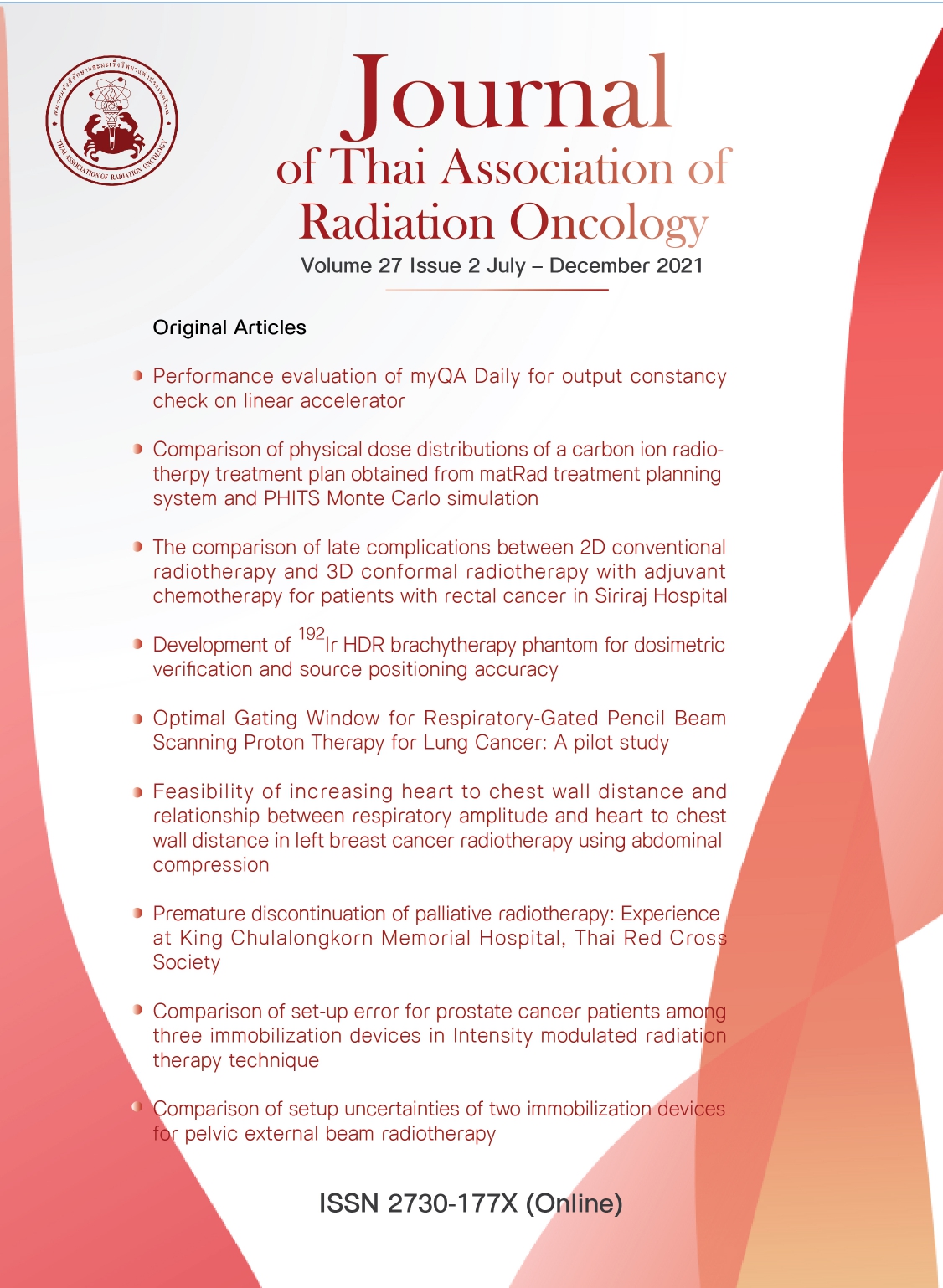Comparison of physical dose distributions of a carbon ion radiotherapy treatment plan obtained from matRad treatment planning system and PHITS Monte Carlo simulation
Keywords:
Carbon ion radiotherapy, treatment planning, Monte Carlo simulation, matRad, PHITSAbstract
Background: In carbon ion radiotherapy (CIRT) treatment planning, dose prescription is done in term of relative biological effectiveness (RBE)-weighted dose in the unit of Gy(RBE). There are two major biophysical models used in CIRT: the microdosimetric kinetic model (MKM) and the local effect model (LEM). For the same prescribed dose, both RBE models can lead to different physical dose distributions in the patient. Therefore, it is not possible to directly compare clinical data using different RBE models. In the past, the conversion factors between MKM and LEM prescribed doses were evaluated using two treatment plans calculated based on both models. However, direct conversion from a treatment plan to the other based on the underlying biophysical model has not been performed. The latter approach requires the information of the physical dose distribution from a treatment plan and the resulting voxel-by-voxel energy spectra of primary and secondary charged particles, which can be obtained by Monte Carlo simulation.
Objectives: To compare physical dose distributions obtained by Particle and Heavy Ion Transport code System (PHITS) Monte Carlo simulation and matRad treatment planning system, to be used for the conversion of CIRT prescribed doses between the LEM and the MKM.
Material and methods: A virtual water phantom with the size of 50 x 35 x 50 cm3 was generated. The target was defined as a spherical volume with a radius of 3 cm, centered at 7 cm water-equivalent depth from the entrance surface of the phantom. Treatment planning of the target was performed with an open-source treatment planning system matRad with the prescribed dose of 4.3 Gy(RBE). The parameters from matRad including number, position, energy and width of carbon ion beam spots were used to define sources in PHITS. Physical dose distributions from matRad and PHITS were compared using the gamma analysis method.
Results: The differences between the Bragg peak positions from matRad and PHITS for monoenergetic carbon ion beams were approximately 1 mm. By shifting the water phantom 1 mm upstream of the beam entrance in the Monte Carlo simulation, the gamma passing rates at 3%/3mm between both sets of physical dose distributions were averagely 99% and 90% in the target region and all regions, respectively.
Conclusion: The combination of matRad and PHITS can be applied to evaluate the conversion factors between LEM and MKM treatment plans, especially in the target region.
References
Inaniwa T, Furukawa T, Kase Y, Matsufuji N, Toshito T, Matsumoto Y, et al. Treatment planning for a scanned carbon beam with a modified microdosimetric kinetic model. Phys Med Biol. 2010;55:6721. doi: 10.1088/0031-9155/55/22/008.
Inaniwa T, Kanematsu N, Matsufuji N, Kanai T, Shirai T, Noda K, et al. Reformulation of a clinical-dose system for carbon-ion radiotherapy treatment planning at the National Institute of Radiological Sciences, Japan. Phys Med Biol. 2015;60:3271.
Scholz M, Kellerer A, Kraft-Weyrather W, Kraft G. Computation of cell survival in heavy ion beams for therapy. Radiat Environ Biophys. 1997;36:59-66. doi: 10.1007/s004110050055.
Krämer M, Scholz M. Treatment planning for heavy-ion radiotherapy: calculation and optimization of biologically effective dose. Phys Med Biol. 2000;45:3319.
ICRU M. Report 36. International Commission on Radiation Units and Measurements, Bethesda, MD 1983.
Molinelli S, Magro G, Mairani A, Matsufuji N, Kanematsu N, Inaniwa T, et al. Dose prescription in carbon ion radiotherapy: How to compare two different RBE-weighted dose calculation systems. Radiother Oncol.2016;120:307-12. doi: 10.1016/j.radonc.2016.05.031.
Fossati P, Molinelli S, Matsufuji N, Ciocca M, Mirandola A, Mairani A, et al. Dose prescription in carbon ion radiotherapy: a planning study to compare NIRS and LEM approaches with a clinically-oriented strategy. Phys Med Biol. 2012;57:7543. doi: 10.1088/0031-9155/57/22/7543.
Wang W, Huang Z, Sheng Y, Zhao J, Shahnazi K, Zhang Q, et al. RBE-weighted dose conversions for carbon ionradiotherapy between microdosimetric kinetic model and local effect model for the targets and organs at risk in prostate carcinoma. Radiother Oncol. 2020;144:30-6. doi: 10.1016/j.radonc.2019.10.005.
Wieser HP, Cisternas E, Wahl N, Ulrich S, Stadler A, Mescher H, et al. Development of the open‐source dose calculation and optimization toolkit matRad. Med Phys. 2017;44:2556-68. doi: 10.1002/mp.12251.
Elsässer T, Weyrather WK, Friedrich T, Durante M, Iancu G, Krämer M, et al. Quantification of the relative biological effectiveness for ion beam radiotherapy: direct experimental comparison of proton and carbon ion beams and a novel approach for treatment planning. Int J Radiat Oncol Biol Phys. 2010;78:1177-83. doi: 10.1016/j.ijrobp.2010.05.014.
Low DA, Harms WB, Mutic S, Purdy JA. A technique for the quantitative evaluation of dose distributions. Med Phys. 1998;25:656-61. doi: 10.1118/1.598248.
Sato T, Niita K, Matsuda N, Hashimoto S, Iwamoto Y, Noda S, et al. Overview of the PHITS code and its application to medical physics. Prog Nucl Sci Technol. 2014;4:879-82. doi:10.15669/PNST.4.879
Sato T, Kase Y, Watanabe R, Niita K, Sihver L. Biological dose estimation for charged-particle therapy using an improved PHITS code coupled with a microdosimetric kinetic model. Radiat Res. 2009;171:107-17. doi: 10.1667/RR1510.1.
Sato T, Iwamoto Y, Hashimoto S, Ogawa T, Furuta T, Abe S-i, et al. Features of particle and heavy ion transport code system (PHITS) version 3.02. J Nucl Sci Technol. 2018;55:684-90. doi:10.1080/00223131.2017.1419890
Hong L, Goitein M, Bucciolini M, Comiskey R, Gottschalk B, Rosenthal S, et al. A pencil beam algorithm for proton dose calculations. Phys Med Biol. 1996;41:1305. doi: 10.1088/0031-9155/41/8/005.
Parodi K, Mairani A, Brons S, Hasch B-G, Sommerer F, Naumann J, et al. Monte Carlo simulations to support start-up and treatment planning of scanned proton and carbon ion therapy at a synchrotron-based facility. Phys Med Biol. 2012;57:3759. doi: 10.1088/0031-9155/57/12/3759.
Yang Z-Y, Tsai P-E, Lee S-C, Liu Y-C, Chen C-C, Sato T, et al., editors. Inter-comparison of dose distributions calculated by FLUKA, GEANT4, MCNP, and PHITS for proton therapy. EPJ Web of Conferences; 2017: EDP Sciences.
Downloads
Published
How to Cite
Issue
Section
License
บทความที่ได้รับการตีพิมพ์เป็นลิขสิทธิ์ของวารสารมะเร็งวิวัฒน์ ข้อความที่ปรากฏในบทความแต่ละเรื่องในวารสารวิชาการเล่มนี้เป็นความคิดเห็นส่วนตัวของผู้เขียนแต่ละท่านไม่เกี่ยวข้องกับ และบุคคลากรท่านอื่น ๆ ใน สมาคมฯ แต่อย่างใด ความรับผิดชอบองค์ประกอบทั้งหมดของบทความแต่ละเรื่องเป็นของผู้เขียนแต่ละท่าน หากมีความผิดพลาดใดๆ ผู้เขียนแต่ละท่านจะรับผิดชอบบทความของตนเองแต่ผู้เดียว




